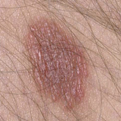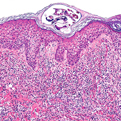Scabies
General Information
Scabies is an infection in the skin caused by a tiny parasite (Sarcoptes scabiei var hominis). The mite that causes the infection is a female. The male fertilizes the female and then dies on the skin; the female then burrows into the skin and deposits eggs in the burrows. The parasite eggs hatch in about 21 days, and work their way up to the surface of the skin where they mature and can spread to other areas of the skin and other people. Burrows appear on the skin as thin, short brown wavy channels. The parasite, the eggs that are buried and the waste they leave behind cause the intense pruritus. Scabies is a highly contagious infection that can be transmitted by close physical contact and sharing of bedding or clothing with an infected individual. Healthcare providers prescribe treatment to patients that have the parasites, household members and close personal contacts. Two medications that are commonly prescribed are permethrin (Elimite, Acticin) and crotamiton (Eurax). The medications kill the mites promptly, but the intense pruritus may not stop for several weeks.
Epidemiology
Common parasitic infection of global proportion
Etiology
Mite S scabiei var hominis
Pathogenesis
Female mite burrows under skin and deposit eggs. After a couple of weeks a type IV hypersensitivity reaction occurs
Clinical
Hives, tiny bites, or pimples. In advanced cases, skin may be crusty or scaly
Histology
Nodular infiltrate composed of lymphocytes and eosinophils
Bibliography
1. “Scabies” (Online).June 2006. http://www.emedicine.com/EMERG/topic517.htm (visited: April 3, 2008) 2. “Scabies” (Online). March 2008. http://www.mayoclinic.com/health/scabies/DS00451/DSECTION=1 (visited: April 3, 2008)
Download PDF
![]() Scabies
Scabies


